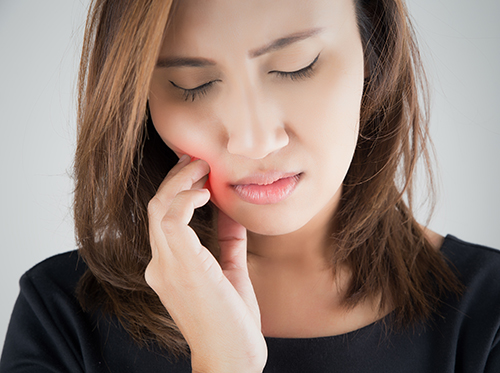Socket Preservation
February 2nd, 2022

Dental implants are a marvel! They look just like your natural teeth, and, even better, they function just like your natural teeth. So, when you’re planning on a dental implant after an extraction, you want to make sure that your implant has the best chance of success—and we do, too. That’s why we might recommend a socket preservation procedure, where socket grafting takes place immediately after your extraction.
What is a socket graft, and what does it “preserve”? Let’s take a closer look.
Socket Preservation—A Logical Choice After Extraction
You’ve decided on a dental implant for some excellent reasons.
- A missing tooth can change the appearance of your smile.
- Your remaining teeth might shift to fill the empty space, causing alignment and bite problems.
- A lost tooth affects the amount, shape, and health of the bone surrounding your teeth.
No one wants to lose a tooth. Sometimes, though, due to injury or decay, an extraction is the only choice for your oral health. After your tooth is extracted, if the socket bone holding the tooth is perfectly healthy and the extraction is a simple one, we might be able to place an implant post in the socket right away.
But often, bone needs time to heal before placing an implant post, and you risk losing the bone size and density you need to make a future implant possible. How can you lose bone? That’s an unfortunate consequence of losing teeth. Teeth are important not just because they let us eat comfortably—they also help maintain bone health.
Without the stimulation of biting and chewing, the bone beneath the teeth begins a process called resorption. As older cells are absorbed back into the body, new bone cells aren’t produced as quickly to replace them. The alveolar bone, the thick ridge of the jaw which holds our sockets, shrinks in size. As the bone gets smaller, gum tissue shrinks around it, causing a sunken spot where your tooth used to be.
For a dental implant to anchor successfully in the jawbone, you need healthy bone that is high enough, wide enough, and dense enough to hold the implant post securely as it fuses with the bone.
A socket graft at the time of extraction provides two important benefits: grafting material fills the empty socket immediately, preserving the bone and gum area around it, and the graft material acts as scaffolding for new bone growth, creating a firm, dense foundation for your implant.
Grafting materials are gradually and safely absorbed as your new, healthy bone tissue replaces them. The result, after several months of healing, is an alveolar ridge with normal height and width and with the density needed to anchor an implant successfully.
The Grafting Procedure
Grafting material comes in different forms, including allografts (made from donor bone), synthetic grafts (made from synthetic materials which function like bone tissue), and autografts (bone taken from your own body). Growth factors may also be included in the grafting material to encourage new cell growth. Drs. Angela Paros, Amer Atassi, Eric Young, Alexander Katsnelson will recommend the type of graft which will work best for you.
A socket preservation procedure will frequently involve the following steps:
- Local anesthesia to numb the area before your extraction. You might choose sedation options as well, which we’re happy to discuss with you in advance.
- Careful cleaning of the site after the tooth is extracted.
- Filling the empty socket with bone grafting material.
- Placing a barrier or membrane over the graft to protect it as it heals.
- Suturing the surrounding gum tissue.
Aftercare Treatment
Aftercare treatment for a socket graft is a lot like the treatment for a tooth extraction. You’ll need to be careful around the graft area for several days as it heals, and we’ll give you specific instructions for your recovery. Normally, these may include:
- Don’t disturb or touch the area. Even pulling on lips or mouth to look at the site can put stress on your sutures.
- Immediately after the procedure, we can give you suggestions for reducing swelling and managing any pain you might be feeling.
- We’ll let you know when and how to rinse your mouth clean and when you can return to brushing. And no spitting!
- Eat carefully. We might recommend a liquid diet for a few days before transitioning to bland and cool soft foods. We’ll let you know the best diet for the period after your surgery. Don’t use a straw for your liquid diet, because suction can interfere with the wound.
- Treat yourself carefully for a few days by avoiding strenuous activities, including workouts.
- Don’t smoke. Smoking interferes with the healing process, and the suction involved does your graft no favors either.
- Visit our Romeoville, IL office for follow up appointments as recommended. We’ll monitor your healing, and give you a timeline for your future implant.
Preserving your socket now instead of repairing it later has many advantages. Immediate placement of a graft protects bone size and density, eliminates the need for a potential bone grafting procedure in the future, and makes it possible for you to enjoy the natural look and feel of a dental implant as soon as possible.
Bone grafting is essential for many periodontal restorations, and we are specialists in this procedure. If you have an extraction scheduled, let’s discuss why socket preservation might be your best path to an efficient, timely, and successful dental implant.
What makes a periodontist different from a dentist?
January 19th, 2022

“Dentists, periodontists … what’s the difference, anyway?” We hear our patients asking this question as they wonder about the difference between the two specialties. Periodontists like Drs. Angela Paros, Amer Atassi, Eric Young, Alexander Katsnelson are more than just oral health professionals. Unlike dentists, who act more like general practitioners, periodontists focus on treating the soft tissue (gums) and bones supporting the teeth, as well gum disorders. Sure, dentists can prevent the onset of gum disease through regular cleanings and prescribing medications. But it is periodontists who are required for more complex and advanced cases of gum disease called periodontitis, a gum infection that, if left untreated, can lead to tooth loss. Periodontitis is a condition that most dentists simply don’t treat. The most severe cases of periodontitis can even lead to serious health problems such as diabetes, heart disease, and cancers of the head, neck, and pancreas.
To make things simpler, we’ve come up reasons for when you should visit the dentist and when you should give us a call to book an appointment with Drs. Angela Paros, Amer Atassi, Eric Young, Alexander Katsnelson:
Visit your general dentist for:
- Checkups and cleanings
- X-rays
- Filling cavities
- Root canals
- Tooth extractions
- Crowns or bridges
- Select cosmetic procedures such as veneers, bonding, and teeth whitening
- Pediatric (children’s) care
Visit Drs. Angela Paros, Amer Atassi, Eric Young, Alexander Katsnelson for:
- Deep pocket cleanings (to remove debris and infection-causing bacteria)
- Bone grafts
- Soft tissue removal
- Scaling and root planing (deep cleaning)
- Implant replacement
- Crown lengthening
- Osteoplasty (hard tissue recontouring)
- Gingivoplasty (soft tissue recontouring)
To learn more about the differences between periodontists like Drs. Angela Paros, Amer Atassi, Eric Young, Alexander Katsnelson and your general dentist, or to schedule your next visit, please give us a call today! We look forward to seeing and treating you!
Toothaches and Abscesses
January 12th, 2022

With Drs. Angela Paros, Amer Atassi, Eric Young, Alexander Katsnelson, emergency dental care is only a phone call away. Dental problems are uncomfortable and should always be treated as soon as possible to prevent them from getting worse.
Whether it’s an abscess or a toothache that you believe might be something more, it’s vital to pay attention to your body and give it the attention it needs. Below, you’ll find some more information about abscesses and toothaches that may clarify any doubts about the differences, whether you may be suffering from one of them … and what to do if you are.
Abscesses
What’s an abscess? It’s a bacterial infection: an accumulation of pus that can form inside a tooth or the gums and cause pain and swelling. It generally develops as a result of poor oral hygiene.
Bacteria lives in plaque so if plaque isn’t removed on a regular basis, it can build up and encourage bacteria to spread, which could ultimately result in an abscess. Antibiotics aren’t always needed for treatment, you should get this situation checked out as soon as possible. If left untreated, oral infections can lead to bigger complications.
Toothaches
Toothaches can happen for a number of reasons. The simplest, most common one is a piece of food that is stuck in your gum, which can cause a bit of swelling and discomfort.
To get rid of it, you can rinse your mouth with hot water and salt, every morning and evening. This helps kill bacteria and bring down the swelling. You can also gently floss the area to remove whatever is stuck there. If you experience bleeding while you’re flossing, and hot water with salt proves ineffective, it may be time to schedule an appointment.
If you’re especially sensitive to cold and heat, you may often experience toothaches. If this is the case, we can recommend a pain reliever to reduce the discomfort, but it’s worthwhile to come in for a check-up anyway to make sure the problem doesn’t get worse.
The last (and most obvious) reason for a toothache is a cavity. Depending on how bad it is, we might fill it or place a crown. The tricky thing with cavities is that sometimes you may not know you have one at all, especially when they’re just starting out. The best way to prevent them from getting worse and creating toothaches is by keeping up with your regular dental cleanings.
At High Point Dental Group, we’re here to assist you through any and all your dental emergencies! We encourage you to make an appointment at our Romeoville, IL office if you notice any signs of discomfort, so we can provide the most efficient care for you.
Resolving to Eat Better in the New Year
December 29th, 2021

It’s a new year, and a resolution found on many lists is learning to be more mindful about healthy food choices. You might have set some of these goals yourself. Gaining, losing, or maintaining your current weight. More fruits and veggies. Better proteins. Less sugar. Fewer carbs. You want to make this new year your healthiest year yet.
And while you’re making your new and improved shopping list, don’t forget your oral health! Because while brushing and flossing are extremely important, your diet can also have very real benefits for your teeth and gums.
Stronger Teeth and Jaws
We often talk about teeth and bones together, and that’s natural. Calcium and phosphorus, as well as other minerals, make them the strongest parts of our bodies. When teeth lose mineral strength, they are more vulnerable to cavities, and bone loss in the jaw can cause loose or even lost teeth.
Making sure you get the recommended daily amount of the minerals and vitamins you need will help sustain and repair both teeth and bones. A diet rich in calcium, phosphorus, and vitamin D helps build strong bones and promotes bone density. While your teeth can’t create new enamel, minerals that are eroded by acids from plaque and acidic foods can be restored, or remineralized, with the calcium and phosphates in saliva.
- Calcium
Strong teeth and bones need calcium. More than 99% of the calcium in our bodies is located in our teeth and bones. How to make sure we get enough?
Dairy products are the traditional answer. Several servings of milk, cheese, or yogurt each day supply most of our needs. If you can’t eat dairy, though, calcium is also found in other foods, such as salmon, sardines, many dark leafy vegetables, and fortified juices, tofu, and cereals.
- Phosphorus
Calcium gets most of the attention when it comes to creating strong teeth and bones, but it’s not a solo act. We need phosphorus to make full use of the calcium in our diets.
Proteins like meat, fish, and poultry are good sources of phosphorus, as are beans, nuts, whole grains and dairy.
- Vitamin D
Vitamin D is a diet essential because it enables us to absorb the calcium and phosphorus that keep teeth and bones strong.
Most dairy and many other foods are fortified with vitamin D, such as cow’s milk, soymilk, orange juice, and cereals. Egg yolks and fatty fish, such as salmon, tuna, and herring, are also a rich natural source of the vitamin.
Healthy Gums
Gum disease is more than just a nuisance. Left untreated, gingivitis (early gum disease) can become periodontitis (serious gum disease). Periodontitis can cause infection, loose teeth, and tooth and bone loss.
Brushing and flossing promote gum health and help prevent gum disease, but your diet plays an important role, too.
- Vitamin A
Vitamin A is essential for the health and healing of mucous membranes, including gum tissue and the soft membranes in the mouth.
You can get this vitamin directly from animal products such as dairy foods and meats, or it can be formed in the body from beta-carotenes. Think orange when you hit the produce aisle, because foods such as carrots, peppers, pumpkin, squash, and sweet potatoes are a rich source of beta-carotenes.
- Vitamin C
Vitamin C is one of the so-called “essential nutrients.” These are the nutrients that are necessary for our bodies to function properly, and which can only be supplied in our diets. Vitamin C is vital for healthy gums and soft tissue—in fact, one sign that your diet is deficient in vitamin C is inflamed and bleeding gums.
Citrus fruits, those oranges, lemons, limes, grapefruit, and all their cousins, are a wonderful source of vitamin C, but you have many other flavorful options. Fruits such as kiwis, mangos, papayas, and strawberries are rich in vitamin C. Step over to the vegetable aisle to load up on red peppers, kale, cauliflower, Brussels sprouts, and broccoli—all of which contain more vitamin C per serving than a medium orange!
Fewer Cavities
Plaque thrives on a diet of sugar. Oral bacteria in plaque use the sugars in our food to produce acids. These acids erode enamel and eventually lead to cavities. Limiting your sugar consumption and choosing complex carbohydrates over simple carbs are two ways to reduce your risk of cavities.
- Sugars
The usual suspects—candies, desserts, pastries, sodas—are sugar-filled items you’re familiar with. What might surprise you is the amount of sugar in sports drinks, fruit juices, flavored yogurts, breakfast cereals, and other standard grocery purchases. Checking labels for sugar content is a great way to cut down on unexpected sweeteners.
- Carbs
The refined starches in white bread, white rice, potato chips, and other simpler carbohydrates quickly break down into sugars. This is the kind of nutrition only plaque appreciates.
Instead, fill your cart with complex carbohydrates, which contain important vitamins, minerals, and fiber. Found in foods like whole-grain breads and cereals, legumes, and many vegetables, complex carbs break down slowly for longer-lasting energy.
Of course, these suggestions don’t cover everything on your healthy dental shopping list. We could add magnesium for bone density, vitamin B to prevent oral irritation and inflammation, vitamin K for bone strength, and more. To find out the best options for your healthiest smile, talk to Drs. Angela Paros, Amer Atassi, Eric Young, Alexander Katsnelson or a member of our Romeoville, IL team about ideas for improving your daily diet.
Because besides leading to stronger teeth, healthier gums, and fewer cavities, a careful and conscious approach to your food choices has another wonderful benefit—a healthy dental diet is healthy for the rest of your body as well. Just something to be mindful of as we greet the new year!






